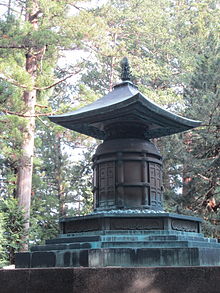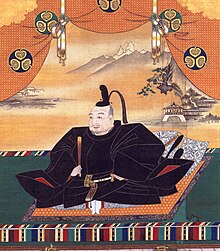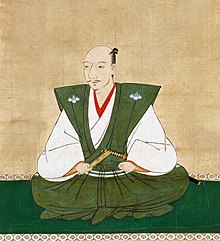Tokugawa Ieyasu
Tokugawa Ieyasu ( Jap. 徳川家康 * 31 January 1543 in Okazaki Castle ; † 1. June 1616 in Sumpu (now Shizuoka )) was the founder of the Tokugawa shogunate in Japan and is regarded by Oda Nobunaga and Toyotomi Hideyoshi as the Third of the three unions of feudal Japan.
Childhood hostage
Ieyasu grew up as Matsudaira Takechiyo ( 松 平 竹 千代 ) in what is now called the " Warring States Period " in Japanese historiography (see also Sengoku-Daimyō ). Central authorities such as Tennō or Shōgun (military rulers) only existed by name, while regional warlords ( daimyō ) vied for power in individual regions in constant small wars. Ieyasu's home country, the fertile province of Mikawa (now part of Aichi Prefecture in central Japan) had belonged to his family, the Matsudaira , for several generations, but these were besieged by two expanding houses, the Oda in the west and the Imagawa in the east. Both of these rival houses sought to either militarily disempower the Matsudaira or win them as vassals.
Ieyasu's youth exemplarily reflects the circumstances of these rough times: in 1548, at the age of five, he spent a year as a war hostage in the power of the Oda, which in 1549 passed him on to the Imagawa in exchange for other hostages. While his parent company came more and more under the influence of the Imagawa, he was brought up to be a vassal of the Imagawa himself. A visible sign was the bestowal of the name moto , which the head of the Imagawa, Yoshimoto, also had in his name. His name was now Matsudaira Motoyasu ( 松 平 元 康 ).
Pact with Oda Nobunaga
At the age of 13, Motoyasu was sent back to his ancestral home in 1556 to take over after the early death of his father Matsudaira Hirotada ( 松 平 広 忠 ). He led the first successful battle against Oda Nobunaga on behalf of the Imagawa . In 1560 he took part in the attempt of the Imagawa to take Kyōto . This bold move failed and cost the Imagawa leader, Imagawa Yoshimoto , his life. Motoyasu used the resulting power vacuum to free himself from the influence of the Imagawa, and instead secretly allied himself with Oda Nobunaga, whose military expansion he subsequently supported.
The secrecy was necessary because most of the Matsudaira family, including Motoyasu's wife and son, were still being held hostage by Imagawa Ujizane , son of Yoshimoto. In 1561, he and his men took Imagawa Castle's Kamino Castle, signaling to Oda Nobunaga that he was no longer loyal to the Imagawa. Motoyasu killed the commander of the fortress and traded his wife and two sons with the Imagawa for his own family.
In 1566 he had his meanwhile increased prestige confirmed by the imperial court in Kyoto. As a sign of his (historically not verifiable) descent from the prestigious house of the Minamoto , he obtained a change of his name. Since then he has called himself Tokugawa Ieyasu - possibly an indication that he wanted nothing more to do with past family loyalty.
After Ieyasu had succeeded in 1570 to incorporate the possessions of the Imagawa, he came across another territorial prince, who at that time successfully expanded his possessions, Takeda Shingen . Your first armed conflict in 1572 brought Ieyasu one of his few critical defeats, from which he just got away with his life. Due to the sudden death of Shingen in 1573 Ieyasu finally succeeded in pushing back the Takeda with the support of Nobunaga. Apparently the Oda-Tokugawa alliance was not beyond doubt. In 1579 Ieyasu's main wife Tsukiyama and his eldest son and heir Nobuyasu (1559–1579) were suspected of colluding with the Takeda. Pushed by Nobunaga, Ieyasu executed his wife and forced his son to commit suicide.
Ieyasu and Hideyoshi
In 1582 Oda Nobunaga was murdered by his vassal Akechi Mitsuhide . Another of Nobunaga's general, Toyotomi Hideyoshi , “avenged” Nobunaga's death and thereby took over his territorial and military legacy. Ieyasu consolidated his influence on the former Imagawa and Takeda territories during this period. In 1584 there was a military exchange of blows between Hideyoshi and Ieyasu, which ended in favor of the latter. Ieyasu used his victory to evade Hideyoshi's direct authority, but subsequently established himself as an equal ally. In 1590, Tokugawa and Toyotomi troops marched together to the east and brought down the fortress Odawara of the mighty Hōjō after a 6-month siege. This secured them the decisive influence on the Kanto plain , the traditional heartland of the eastern provinces of Japan. Hideyoshi then offered Ieyasu to take over the Kantō holdings of the Hōjō alone, but to cede his previous possessions to Hideyoshi. Territorially, this trade looked like a profit for Ieyasu, but in fact Hideyoshi sought to keep Ieyasu from Kyoto, the political and cultural center of the country, as far as possible. Ieyasu surely saw through this, but consented to avoid a military conflict with Hideyoshi.
Ieyasu set up his headquarters in Edo , an insignificant fishing village. As a result, it developed into a flourishing city and was finally to become the seat of the Tenno in 1868 under the name Tōkyō (eastern capital) .
Founding of the Tokugawa Shogunate
When Hideyoshi died in 1598, Ieyasu and four other daimyo were among the Five Regents to whom Hideyoshi had entrusted the care of his underage heir in his will. Instead of really advocating the Toyotomi cause, Ieyasu acted - first covertly, then more and more openly - in his personal interest, just as Hideyoshi had done in the case of Nobunaga's heirs. In 1600 Hideyoshi's followers therefore split into a western camp, led by Ishida Mitsunari , and an eastern camp , led by Ieyasu. Ieyasu was able to win the decisive battle of Sekigahara , which is said to have been the largest battle on Japanese soil to date. This made him the undisputed military ruler of Japan. According to general opinion, this marks the beginning of the Edo period , which was politically dominated by the Tokugawa in Edo.
In 1603 Ieyasu sealed his leading position by having the Tennō give himself the title of Shogun . Instead of 1600, the year 1603 is sometimes given as the beginning of the Edo period. In contrast to Oda Nobunaga and Toyotomi Hideyoshi, Ieyasu thought of securing his position for his descendants in good time. In 1605 he ceded the title of Shogun to his son Tokugawa Hidetada , but kept the political threads of the country firmly in hand in the background. From then on, his policy was aimed at consolidating the existing balance of power and eliminating all potential sources of conflict. These included the Christian mission, which, together with European traders, had a significant influence on the events of that time, but also the descendants of Hideyoshi, who resided in the fortress of Osaka .
Ieyasu tackled both problems with merciless severity at the advanced age of over 70. In 1613 he had an embassy under Hasekura Tsunenaga sailed on a diplomatic mission to Mexico and to the Pope in Rome. In the same year, however, there was a total ban on Christian missions (bateren tsuihōrei) , missionaries and even Christian daimyo were expelled and later executed. In 1614, Ieyasu found a flimsy pretext to take action against Hideyoshi's heir, Toyotomi Hideyori . In 1615 there was a decisive attack on the castle of Osaka by the troops of the shogunate. After their fall, Hideyori and his mother committed suicide. His son Kunimatsu was executed although he was married to a granddaughter of Ieyasu and was consequently a blood relative of the Tokugawa.
Afterlife and aftermath

A year later, on June 1, 1616, Ieyasu died of natural causes at his retirement home in Sumpu, the Imagawa castle where he had spent his childhood as a hostage. Like everything else, he seems to have prepared his death well. Guided by his religious advisers Tenkai and Sūden , he had a rite tailored according to which he should continue to watch over the fate of his family and the country as the deity Tōshō Daigongen ( 東 照 大 権 現 ). His grandson Iemitsu , the third Tokugawa shogun, had Ieyasu's cult and its mausoleum expanded on a large scale. The result can still be admired today in the Tōshō-gū shrine of Nikkō , where Ieyasu and his grandson (in a separate shrine) are buried. In Japan many other shrines (called Tōshō-gū ) are dedicated to him. In addition to the Tōshō-gū, Ieyasu is venerated as a kami in other Shintō shrines , including the Iga Hachiman-gū in Okazaki (together with Ōjin -tennō, Chūai -tennō and Jingū -kōgō), the Tatsuki shrine in Okazaki (together with Honda Tadakatsu ) and side shrines, u. a. at Chichibu Shrine ( Chichibu , Saitama Prefecture ), the Three Mountains of Dewa , Hie Taisha , Mitake Shrine ( Yamanashi Prefecture ) and Mitsumine Shrine (Saitama Prefecture).
The Tokugawa shogunate founded by Ieyasu existed until the middle of the 19th century . Despite or perhaps because of the strict policy of isolation ( 鎖 国 政策 , sakoku seisaku , literally: political measure to close off the country ) of the Tokugawa to the outside world and the police-state-like surveillance of the population, it was a long period of internal stability and cultural prosperity.
Ieyasu in entertainment culture
- The story of Ieyasu's rise is one of the most famous and beloved in Japanese historiography.
- She can also be found in the novel Shogun by James Clavell , in which Ieyasu is portrayed as the fictional Shogun Toranaga. The Englishman William Adams (Japanese name Miura Anjin ), appointed by Ieyasu as a samurai, is immortalized there as John Blackthorne.
- Ieyasu's epic battle with the Takeda was filmed in Kurosawa Akira's Kagemusha .
- A popular Japanese poem:
- "What to do if the bird doesn't want to sing?"
- Nobunaga replies: "Kill him!"
- Hideyoshi replies: "Make him want to sing."
- Ieyasu replies: "Wait."
- Another bon mot connects the three unions with the production of mochi (rice cake): Nobunaga beats the rice to a pulp, Hideyoshi turns it, Ieyasu eats it.

- In Tōshōgū there is a sculpture of a (apparently?) Sleeping cat above the gate that leads to Ieyasu's actual tomb. It is said that the artist Hidari Jingoro alluded to the shogun's devious character with this depiction.
- In the computer game add-on The Asian Dynasties for the strategy game Age of Empires III , a campaign can be played in which one helps leyasu to rise.
- In the manga Basilisk , Ieyasu appears as a minor character.
- In the Star Trek novel " The Touchstone of Her Past " by Dana Kramer Rolls, part of his story is told.
- In the game series " Sengoku Basara " and "Samurai Warriors (Sengoku Musou)" Ieyasu can be found as a character.
literature
- AL Sadler : The maker of modern Japan: the life of Tokugawa Ieyasu , Rutland, Vermont: Tuttle 1981, ISBN 0-8048-1297-7
- Conrad Totman: Tokugawa Ieyasu, shogun: a biography , San Francisco: Heian International, 1983, ISBN 0893462101
- Willem Jan Boot: "The death of a shogun: deification in early modern Japan". In: John Breen and Mark Teeuwen (eds.): Shinto in History - Ways of the Kami , Curzon, London 2000, ISBN 0-7007-1172-4 , pp. 144–166.
Web links
- Detailed biography: Samurai Archives: Tokugawa Ieyasu (English)
| personal data | |
|---|---|
| SURNAME | Tokugawa Ieyasu |
| ALTERNATIVE NAMES | 徳 川 家 康; Matsudaira Takechiyo; Matsudaira Motoyasu |
| BRIEF DESCRIPTION | japanese unifier of feudal japan |
| DATE OF BIRTH | January 31, 1543 |
| PLACE OF BIRTH | Okazaki Castle |
| DATE OF DEATH | June 1, 1616 |
| Place of death | Sumpu, today Shizuoka |



